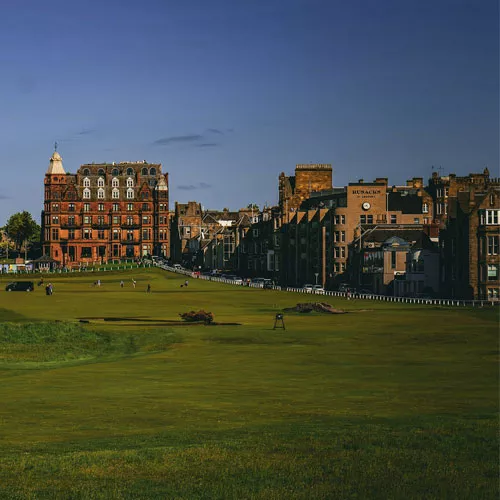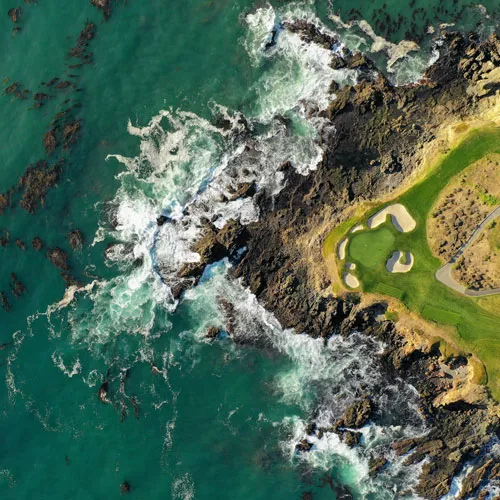At Golf Gear Direct, we often field questions from golfers about various aspects of the game. One topic that frequently comes up is the difference between a traditional golf course and a links golf course. Whether you're a seasoned player or new to the sport, understanding these distinctions can enhance your appreciation of the game and potentially influence your golf equipment choices. In this comprehensive guide, we'll explore the unique characteristics of both types of courses and how they can affect your play.
Before we delve into the specifics, it's important to understand the historical context of golf courses. The sport of golf, as we know it today, originated in Scotland during the 15th century. The earliest golf courses were naturally occurring landscapes along the coast, which eventually came to be known as links courses. As the game spread across the world, new types of courses were developed to suit different terrains and climates, leading to what we now generally refer to as inland courses or parkland courses.
The term "links" is derived from the Old English word "hlinc," meaning rising ground or ridge. In the context of golf, links refer to the strip of land along a coast characterised by sandy soil, dunes, and sparse vegetation. True links courses are relatively rare, primarily found in Scotland, Ireland, and a few other coastal areas around the world.
Coastal Location: True links courses are always located along the seaside, typically occupying the links land between the beach and more fertile inland areas. Natural Terrain: Links courses are built on sandy terrain with natural undulations. The landscape has been shaped by wind and sea for thousands of years, resulting in a rugged, uneven terrain.
Few Trees: Due to the coastal winds and sandy soil, links courses typically have very few, if any, trees. The absence of trees exposes the course to strong winds, making wind management a crucial skill for players.
Firm and Fast Turf: The sandy soil provides excellent drainage, resulting in firm, fast-playing surfaces. This affects how the ball rolls and bounces, requiring players to adapt their strategies accordingly.
Pot Bunkers: Links courses often feature deep, steep-edged bunkers (often called pot bunkers) that can be particularly challenging to escape from.
Undulating Greens: The putting greens on links courses tend to be less manicured and more undulating, reflecting the natural contours of the land.
Gorse and Long Grass: Instead of trees, links courses often have areas of gorse bushes and long, wispy grass (often called fescue) that can severely punish errant shots.
Variable Weather: Being coastal, links courses are subject to rapidly changing weather conditions, particularly wind, which can significantly impact play.
Ground Game: The firm turf and open approaches to greens often allow for a "ground game" approach, where players can use low, running shots rather than always flying the ball to the target.

When most people think of a golf course, they're likely picturing what's known as a parkland course or inland course. These are the more common type of golf courses found around the world, especially in areas away from coastlines.
Inland Location: Unlike links courses, traditional courses can be located anywhere, from suburbs to mountainous regions.
Landscaped Terrain: While some natural features may be incorporated, traditional courses are often heavily landscaped to create specific challenges and aesthetic appeal.
Tree-Lined Fairways: Most traditional courses feature numerous trees, often pine trees, lining the fairways and scattered throughout the course. These trees play a significant role in strategy and shot-shaping.
Softer Turf: Inland courses often have richer soil and more regular watering, resulting in softer, more lush turf. This affects how the ball sits on the fairway and how it reacts when landing on the green.
Water Hazards: Lakes, ponds, and streams are common features on traditional courses, adding both beauty and challenge to the layout.
Manicured Bunkers: Bunkers on traditional courses are usually less severe than those on links courses, with sand that's often softer and easier to play from.
Smoother Greens: Putting greens on traditional courses tend to be more meticulously maintained, often resulting in smoother, faster surfaces.
More Predictable Conditions: While weather can always be a factor, traditional courses generally offer more consistent playing conditions from day to day.
Aerial Game: The softer turf and presence of hazards often necessitate a more aerial approach to the game, with players needing to fly the ball all the way to their targets more frequently.
It's worth noting that many modern courses are designed in a "links style," attempting to recreate some of the characteristics of true links courses in non-coastal locations. These links style golf courses may incorporate elements like firm turf, few trees, and strategic bunkering, but they lack the coastal location and natural sandy terrain of true links courses.
Understanding the differences between links and traditional courses is more than just an interesting bit of golf trivia. These distinctions can have a significant impact on how you approach your game and even the equipment you choose to use.
On a links course, the firm turf and open approaches to greens often allow for a variety of shot types. The "ground game" – using low, running shots – becomes a viable and often preferable option. Players might choose to land the ball well short of the green and let it roll up to the hole. This is particularly useful in windy conditions, where keeping the ball low can help maintain control.
Links courses often feature blind shots, where the golfer cannot see the landing area from the tee box or fairway. This adds an extra layer of challenge and requires local knowledge or good course management.
In contrast, traditional courses often require a more aerial approach. With softer fairways and greens, along with strategically placed hazards, players usually need to fly the ball all the way to their target. This puts a premium on accurate iron play and the ability to control ball flight.
The unique characteristics of links golf often require a different set of clubs in your bag. For example:
Hybrid Clubs: These can be particularly useful on links courses, where you might need to hit low, running shots from tight lies.
Lower Lofted Wedges: The firm turf of links courses can make high-lofted wedges bounce and skid. Many players opt for lower-lofted options to maintain control.
Putters: Some players prefer a heavier putter on links courses to cope with the often windy conditions and more undulating greens.
Higher Lofted Wedges: To help you stop the ball quickly on softer greens.
Fairway Woods: These can be useful for longer approach shots, especially if you need to carry hazards.
On links courses, the wind plays a crucial role. The lack of trees and coastal location mean that wind is almost always a factor. This tests a golfer's ability to control ball flight and often requires creativity in shot-making. On traditional parkland courses, while wind can still be a factor, the presence of trees and other features often provides some shelter.
To help illustrate these differences, let's look at some famous examples of each type of course:
The Old Course at St Andrews (Scotland): Often referred to as the "Home of Golf," this is perhaps the most famous links course in the world and a true test of a golfer's ability.
Royal County Down (Northern Ireland): Known for its beautiful setting and challenging play, it's widely regarded as one of the best courses in the world.
Royal St George's (England): A regular host of The Open Championship, this course epitomizes links golf.
Pebble Beach Golf Links (California, USA): While not a true links in the traditional sense due to its location, it embodies many links characteristics and is set along the Pacific Ocean.
Royal Troon (Scotland): Another classic links course and frequent host of The Open Championship.
Augusta National (Georgia, USA): Home of the Masters Tournament, known for its immaculate condition and challenging greens.
Wentworth Club (Surrey, England): A quintessential parkland course, host to the BMW PGA Championship.
Valderrama Golf Club (Spain): A tree-lined course that has hosted numerous professional tournaments and PGA Tour events.
Sunningdale Golf Club (England): One of the most famous parkland courses in the world. Royal Melbourne (Australia): While it has some links-like characteristics, it's generally considered a parkland course and is one of the best in the Southern Hemisphere.

Bandon Dunes Golf Resort (Oregon, USA): While not in the UK or Ireland, this resort features several world-famous links-style courses along the Oregon coast.
Sand Valley (Wisconsin, USA): An inland course designed to mimic the playing characteristics of links golf.
Alwoodley Golf Club (England): Designed by Alister MacKenzie (who also designed Augusta National), this inland course has many links-like features.
Many golf fans and players consider links golf to be the ultimate test of a golfer's skill. It's no coincidence that The Open Championship, golf's oldest major tournament, is always played on links courses. The combination of firm turf, coastal winds, and strategic challenges posed by links courses creates a unique and demanding environment that tests every aspect of a player's game.
The differences between links and traditional golf courses highlight the wonderful diversity of our sport. Each type of course offers its own unique challenges and rewards, testing different aspects of a player's skill and strategy.
For the avid golfer, experiencing both types of courses can greatly enrich your golfing journey. Links golf, with its connection to the sport's origins and its call for creativity and adaptability, offers a unique thrill. Traditional courses, with their manicured beauty and strategic design, provide a different but equally engaging test of golf skills.
At Golf Gear Direct, we believe that understanding these differences can not only improve your appreciation of the game but also help inform your equipment choices. Whether you're preparing for a links golf adventure or honing your skills on your local parkland course, having the right clubs and knowing how to use them can make all the difference.
Remember, golf is a game to be enjoyed in all its forms. Whether you're battling the wind on coastal links, threading your drive between trees on an inland course, or even trying your hand at desert courses, each round offers a new adventure. So get out there, experience different courses, and most importantly, enjoy the beautiful game of golf in all its varieties!